iPad mini Review
by Anand Lal Shimpi & Vivek Gowri on November 20, 2012 6:10 PM ESTDisplay Analysis
As with a discussion on performance in mobile devices these days, the iPad mini's display requires both an experiential analysis and an objective performance analysis. I'll begin with the experience.
Without a doubt, the iPad mini presents an evolution in form factor and nothing else. Everything from silicon to display technology are known quantities at this point. While it's true that in many senses, even Apple's previous generation mobile hardware is pretty good, the fact of the matter remains that the mini doesn't push the envelope in anything but form factor. That's not necessarily a bad thing, it's just reality. I should also point out that many smaller-versions-of-bigger-things follow this same approach of not pushing the performance envelope for obvious reasons.
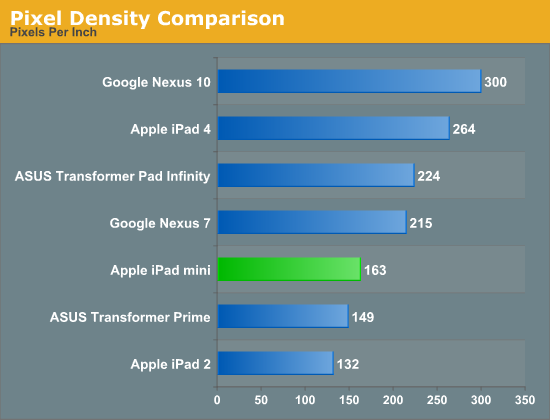
Doing the math on the mini's 1024 x 768 display results in a pixel density of 163 pixels per inch. A tangible improvement compared to the original iPad's 132 PPI, but keep in mind the smaller screen may have to be held closer to your eyes. Compared to other tablets, the mini's display resolution isn't anything to write home about. In practice, the mini's makes reading small text a problem:

While the 3rd and 4th gen iPads have a large enough display at a high enough resolution to make it possible to view the Dell configurator in the photo above without zooming, the same can't be said for the iPad mini. You're going to need a double tap.
Although reading text is one area where the absence of insane numbers of pixels is clearly obvious, it's visible in some photos as well.

iPad mini (left) vs. iPad 4 (right)
Where a lack of fine detail doesn't get you, the physical size of the display may. I was pleasantly surprised by the usefulness of Apple's 7.85-inch display, but given my early affinity towards 8-inch tablets it's not too shocking. Despite how useful the mini's display is, I found myself having to double tap to zoom in on most desktop websites just to make the reading a bit better. It's not that the process of zooming in on a website in mobile Safari is particularly cumbersome, it's that the fact that I have to makes me feel like I'm using more of an iPod Touch and less of an iPad. I do admit the feeling is quite irrational as I prefer keeping the iPod Touch (or iPhone in the case of, reality) holstered and using the mini instead. This is less a criticism of the iPad mini and more guidance for those deciding between mini and regular sizes of the iPad.
Compared to a true 7-inch tablet like the Nexus 7, the additional screen size is definitely appreciated - particularly when reading web pages:
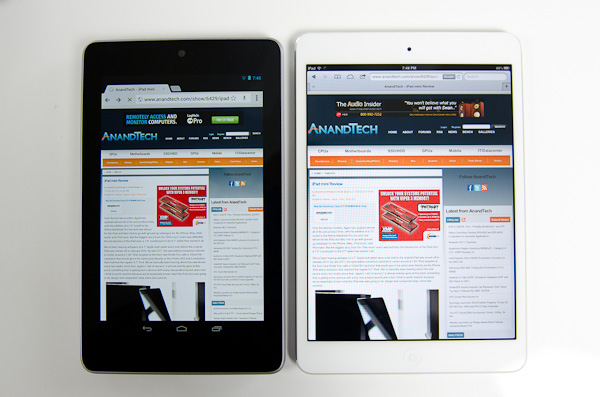
Nexus 7 (left) vs iPad mini (right)
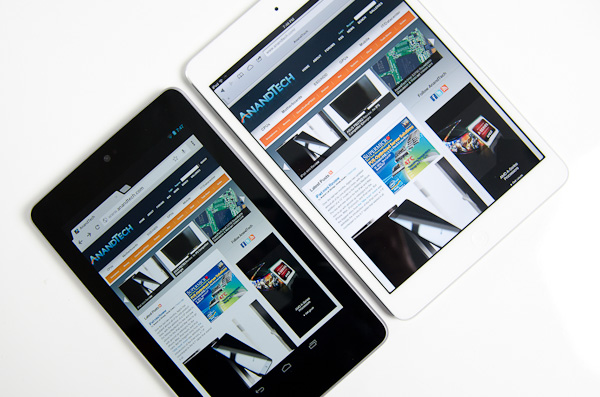
Nexus 7 (left) vs iPad mini (right)
When Vivek and I brought up the topic of the mini's lower pixel density on the Podcast, our own Brian Klug pointed out the obvious: we're spoiled. How impressed/unimpressed you are with the iPad mini's display really depends on what other displays you've been exposed to. In a vacuum, the iPad mini's display is fine. Brightness, black levels and contrast are all reasonable (and much better than most notebooks). Color reproduction isn't bad either. In the spectrum of all displays available at the mini's price point, this 7.85-inch 1024 x 768 panel isn't bad. Spend any appreciable time with the bigger iPad's Retina Display however, and your opinion will quickly change.


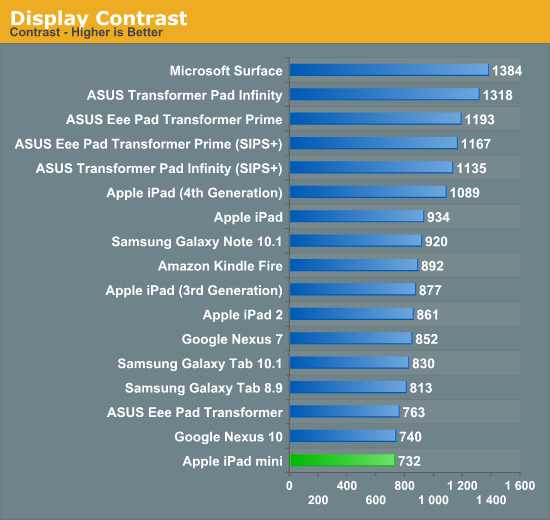
In our Surface review I titled the display section "Not Retina, But Still Good". Compared to the Surface display, the mini has better color accuracy but clearly loses out in black levels thanks to Microsoft's laminated display + cover glass stack.
To evaluate color accuracy I turned to our own Chris Heinonen's CalMAN smartphone/tablet workflow. We'll start off by looking at the calibrated white point for these tablets. What you're looking for here is a number close to 6500K:
The mini doesn't really diverge from other iPads here, although Microsoft comes closer to 6500K at 200 nits.
The next three charts look at accuracy represented as a difference between various source colors and what's reproduced on the display. The results are presented as average dE2000, with lower numbers being better.
First up is Grayscale performance, here we're looking at the accuracy of black, white and 19 shades of gray spread in between the two extremes:
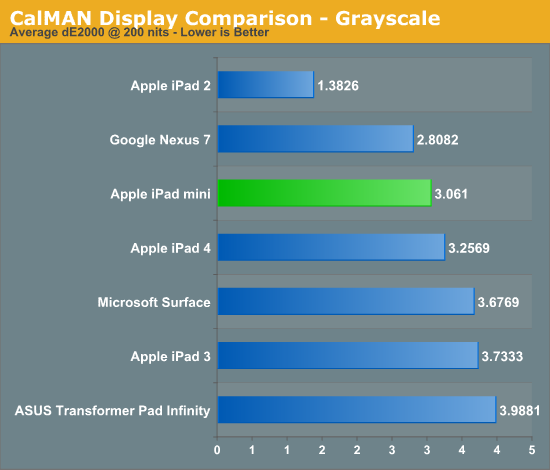
The mini does reasonably well here, it actually ends up a bit better than the 4th gen iPad. Grayscale accuracy doesn't seem to be too difficult for most folks to get right, but what happens when we start looking at colors?
First in our color accuracy tests is a saturation sweep. Here we're looking at 20%, 40%, 60%, 80% and 100% saturations of red, blue, green, magenta, yellow and cyan.
Now we start to see the retina equipped iPads pull away from the mini. Compared to the iPad 2 and even Microsoft's Surface, the mini looks pretty good, but if you compare it to the Nexus 7 or newer iPads it's clearly at a disadvantage. All of these displays are significantly better than the average notebook panel. As I mentioned earlier, it all boils down to perspective and expectations.
Gamut CIE Chart

Saturation CIE Chart

For our final accuracy test we're looking at the difference between a Gretag Macbeth colorchecker chart and the rendered swatches on these displays. Once again, lower numbers are better.
Once again, the iPad 3/4 can't be touched here, with the iPad mini falling significantly behind. Colors simply look better on the bigger iPads. The Nexus 7 does better here as well. Subjectively I found colors on the Nexus 7 to look appreciably more accurate than on the mini.
GMB Color Checker
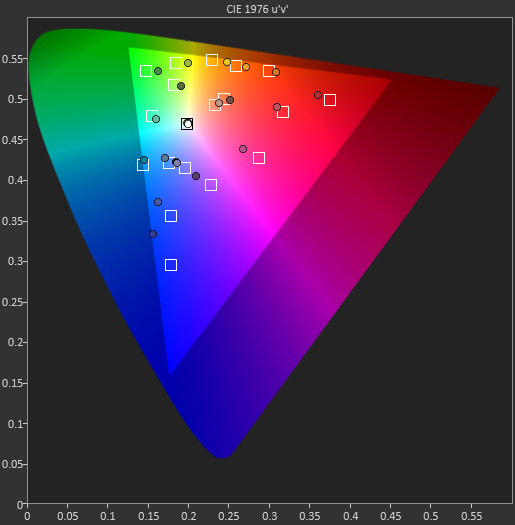
With regards to the quality and accuracy of the images rendered on the mini's screen, I feel the same way about it as I do the display on Surface: it's not a Retina display, but still good.


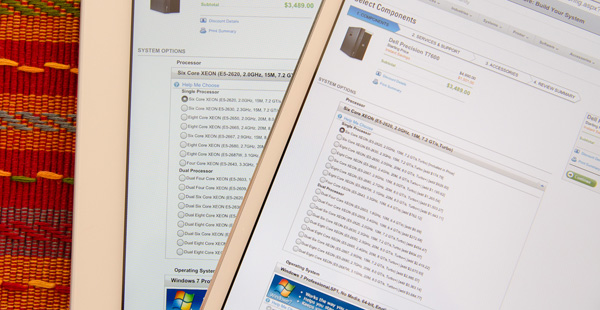
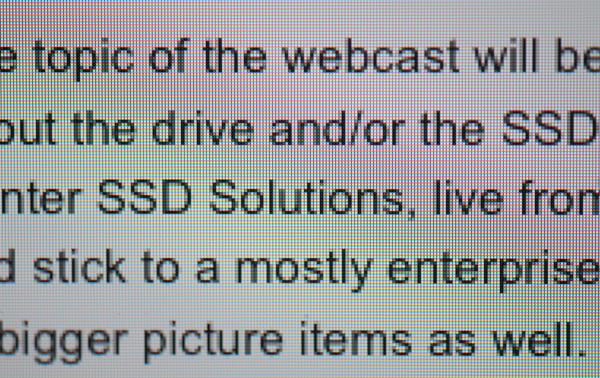
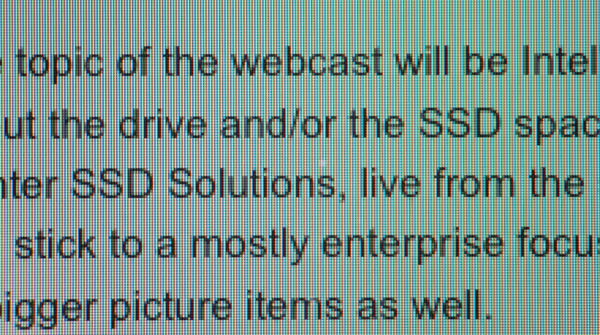
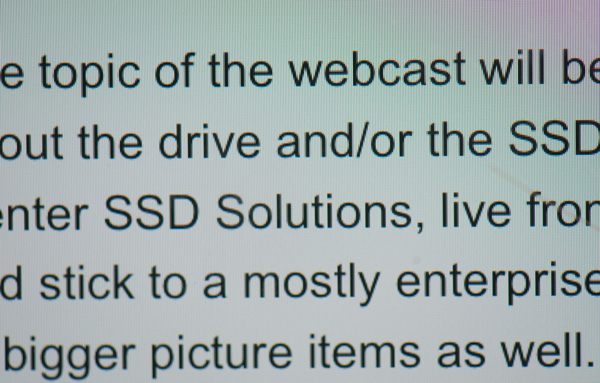
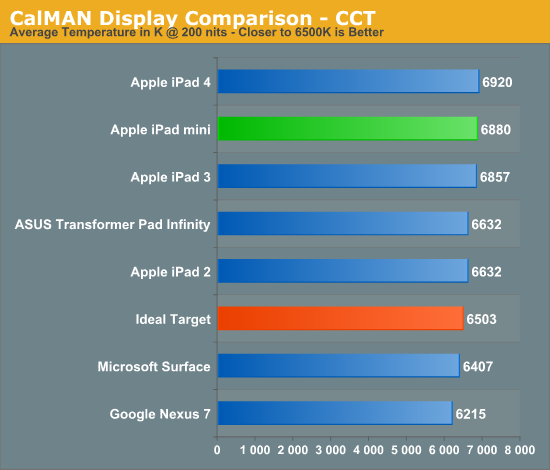
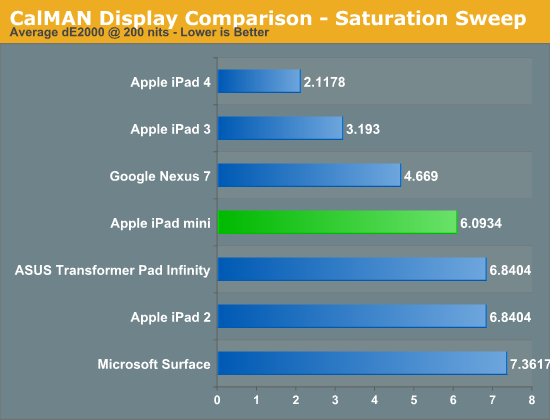
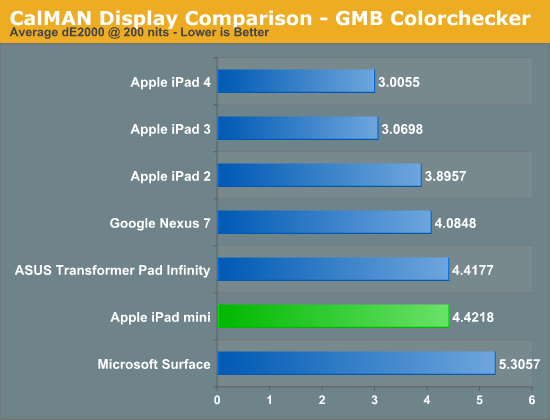








140 Comments
View All Comments
protomech - Tuesday, November 20, 2012 - link
Top of the summary gives it away:"In my first week with the iPad mini, it quickly became the iPad I actually wanted to carry around. The mini's form factor is really where all of the innovation is. It's thin, light and an almost perfect balance of functional screen size and portability. I really love this form factor."
By specs, the mini is unimpressive. It's using a SOC introduced in early 2011. We've been accustomed to high resolution mini-tablets from B&N, Amazon, Google, etc. It has less memory and costs significantly more (particularly for higher SKUs).
But, at least for the reviewer, the form factor trumps all these things, at least for purposes of a "carry computer". Thinner and lighter than the 7" tablet comparison, with significantly more usable display space (Android 4.x soft buttons do not help here) in nearly the same frontal area.
Would it be a better product if it sported an A6X SOC and a retina display? Certainly, on paper. It also likely would need a ~25 Wh battery and substantial increases in both weight and thickness .. same sort of changes from the iPad 2 to iPad 3.
iPad mini should have been introduced last year when the 32nm SOC was available IMO .. it would have provided a useful bifurcation vs the 3rd gen iPad's bulk gains, and perhaps we'd have an A6 SOC in the iPad mini today.
seanleeforever - Tuesday, November 20, 2012 - link
not sure how that quote answers Jorange's questions. but that's the internet nowadays.protomech - Tuesday, November 20, 2012 - link
Is it? It looks like it's a reply to Greg512. Certainly that's how I intended it.But, as you say, that's the internet nowadays.
ltcommanderdata - Tuesday, November 20, 2012 - link
I doubt Apple could have shipped a 32nm SoC last year in volume. The A5r2 was already the first shipping SoC produced on Samsung's 32nm process, ahead of Samsung's own designs, when it launched on the iPad2,4 in March 2012. And that was only used for low volume test production with the 45nm A5 iPad 2 continuing to be available. Apple prioritizing the iPhone 5 to receive a 32nm SoC first and waiting until now for high volume 32nm production to introduce 32nm iPad Mini, 5th gen iPod Touch, and iPad 4 makes sense.protomech - Tuesday, November 20, 2012 - link
Good point.. I thought it had shipped late last year.KoolAidMan1 - Wednesday, November 21, 2012 - link
"By specs, the mini is unimpressive."GPU performance is still surprisingly good, better than even the newest Android-running hardware. What is it with other companies not keeping up with Apple's older hardware?
Greg512 - Wednesday, November 21, 2012 - link
Yea, the GPU is good. But, for the price, the screen, CPU, and RAM are kinda poor. The Mini performs well now, but I question its long-term viability.marvdmartian - Wednesday, November 21, 2012 - link
Typical Apple product, that will sell like hotcakes: getting less, paying more, nothing new.drx11 - Sunday, November 25, 2012 - link
---------------------------------------------------------RE: Not a bad product by marvdmartian on Wednesday, November 21, 2012
Typical Apple product, that will sell like hotcakes: getting less, paying more, nothing new.
---------------------------------------------------------
Typical Fandroid, never sees the forest for the trees.
Apple is the best and has been so since 2007 - at building SoC.
Apple is the best at supporting its devices long term.
Now with iOS 6 - which is mostly supported (not all the features) for an old 3GS phone - you could argue you are getting less - maybe on the older devices (no Siri, Apple Maps is not as good as as Google Maps ... right now... etc..)
Still iOS 5 is very nice for older things and Android/Google/Moto/Samsung/HTC has rarely updated their "better" hardware at all ... you can blame that on the carriers all you want, but that is also what you are buying.
Buying more often, spending more time doing something that maybe should just work?
I know Google is trying (or starting to), but they really have almost no support for the majority (75%+ ) of the devices in their 'ecosystem'. What's the point of better hardware when it runs slower/worse from the start and never gets updated?
Alucard291 - Monday, November 26, 2012 - link
Did you have a joint before you wrote this drivel? Or does your mind work this bad drug free? ^^Good SoCs? Are you serious? Just because people work'd the shaft so hard when A6 came out doesn't mean that Cortex A9 based soc is viable coming into 2013.
Apple is currently behind the curve on both tech processes (28 nm vs 32 nm) and performance (cpu and ram speed but not gpu)
In case of ipad mini. You get less. (2 year old tech) you pay more (than any competition out there). But somehow we miss the forest for the trees?
Oh but it supports the amazing dated and feature free ios6! That's great. Except well.. (opinion incoming) I don't like ios. I find it restrictive and boring.
So your point is?